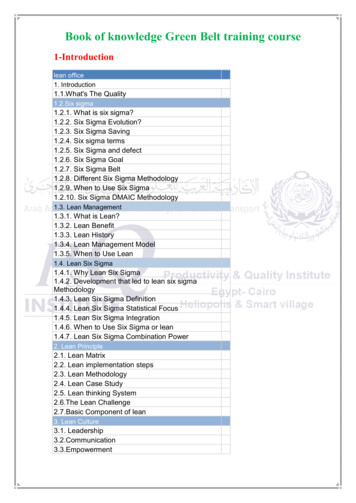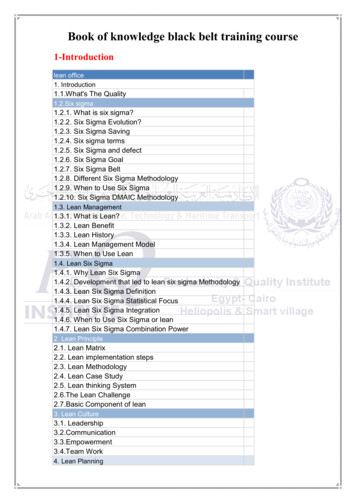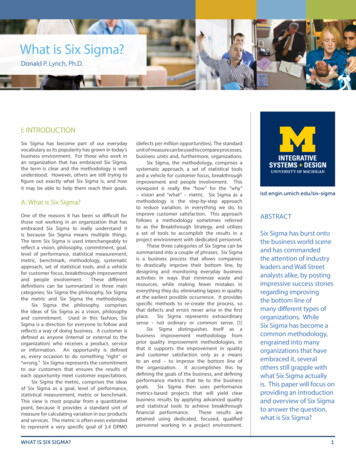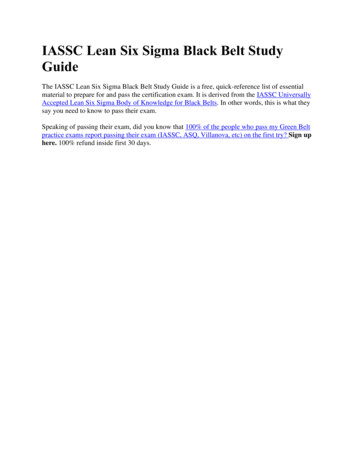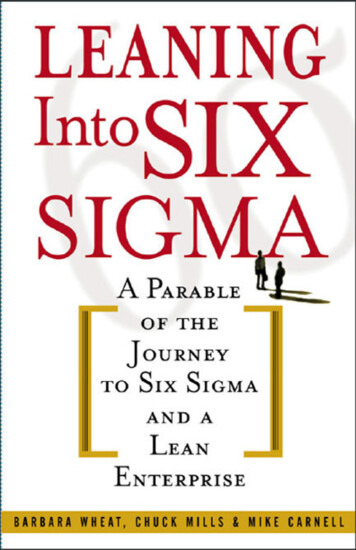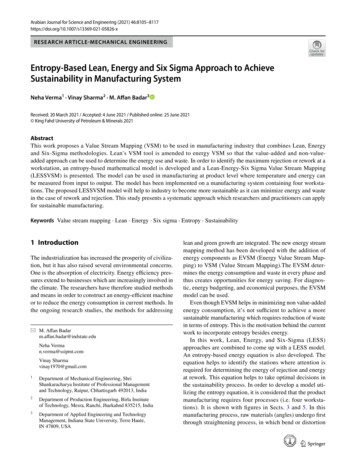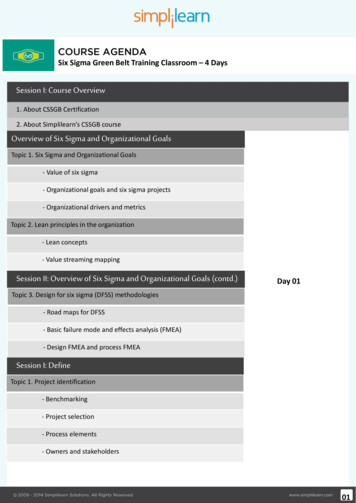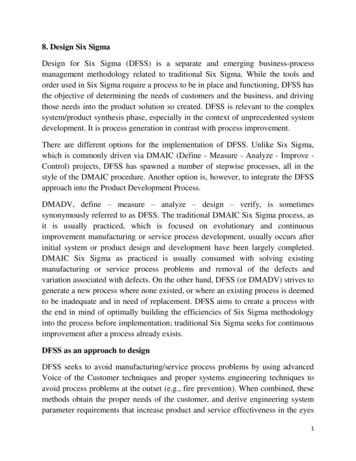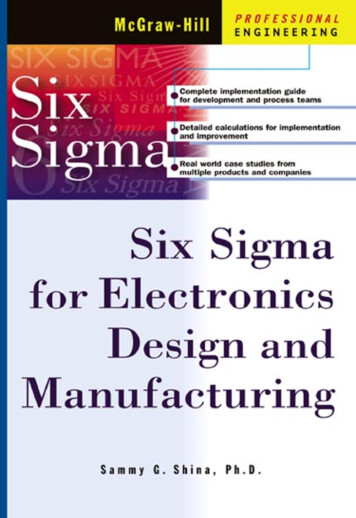
Transcription
Six Sigma forElectronics Designand Manufacturing
This page intentionally left blank.
Six Sigma forElectronics Designand ManufacturingSammy G. ShinaUniversity of Massachusetts, LowellMcGraw-HillNew YorkChicago San Francisco Lisbon London MadridMexico City Milan New Delhi San JuanSeoulSingapore Sydney Toronto
abcMcGraw-HillCopyright 2002 by The McGraw--Hill Companies,Inc. All rights reserved. Manufactured in the United States ofAmerica. Except as permitted under the United States Copyright Act of 1976, no part of this publication may be reproduced or distributed in any form or by any means, or stored in a database or retrieval system, without the prior written permission of the publisher.0-07-140955-6The material in this eBook also appears in the print version of this title:0-07-139511-3.All trademarks are trademarks of their respective owners. Rather than put a trademark symbol after every occurrence of a trademarked name, we use names in an editorial fashion only, and to the benefit of the trademark owner,with no intention of infringement of the trademark. Where such designations appear in this book, they have beenprinted with initial caps.McGraw-Hill eBooks are available at special quantity discounts to use as premiums and sales promotions, or foruse in corporate training programs. For more information, please contact George Hoare, Special Sales, atgeorge hoare@mcgraw-hill.com or (212) 904-4069.TERMS OF USEThis is a copyrighted work and The McGraw-Hill Companies, Inc. (“McGraw-Hill”) and its licensors reserve allrights in and to the work. Use of this work is subject to these terms. Except as permitted under the Copyright Actof 1976 and the right to store and retrieve one copy of the work, you may not decompile, disassemble, reverse engineer, reproduce, modify, create derivative works based upon, transmit, distribute, disseminate, sell, publish or sublicense the work or any part of it without McGraw-Hill’s prior consent. You may use the work for your own noncommercial and personal use; any other use of the work is strictly prohibited. Your right to use the work may beterminated if you fail to comply with these terms.THE WORK IS PROVIDED “AS IS”. McGRAW-HILL AND ITS LICENSORS MAKE NO GUARANTEES ORWARRANTIES AS TO THE ACCURACY, ADEQUACY OR COMPLETENESS OF OR RESULTS TO BEOBTAINED FROM USING THE WORK, INCLUDING ANY INFORMATION THAT CAN BE ACCESSEDTHROUGH THE WORK VIA HYPERLINK OR OTHERWISE, AND EXPRESSLY DISCLAIM ANY WARRANTY, EXPRESS OR IMPLIED, INCLUDING BUT NOT LIMITED TO IMPLIED WARRANTIES OF MERCHANTABILITY OR FITNESS FOR A PARTICULAR PURPOSE. McGraw-Hill and its licensors do not warrantor guarantee that the functions contained in the work will meet your requirements or that its operation will be uninterrupted or error free. Neither McGraw-Hill nor its licensors shall be liable to you or anyone else for any inaccuracy, error or omission, regardless of cause, in the work or for any damages resulting therefrom. McGraw-Hill hasno responsibility for the content of any information accessed through the work. Under no circumstances shallMcGraw-Hill and/or its licensors be liable for any indirect, incidental, special, punitive, consequential or similardamages that result from the use of or inability to use the work, even if any of them has been advised of the possibility of such damages. This limitation of liability shall apply to any claim or cause whatsoever whether such claimor cause arises in contract, tort or otherwise.DOI: 10.1036/0071409556
Want to learn more?We hope you enjoy this McGraw-Hill eBook!If you’d like more information about this book,its author, or related books and websites,please click here.
To my wife, love, friend, and companion Jackie,and our children and grandchildren
For more information about this book, click here.ContentsIllustrations and TablesAbbreviationsPrefaceChapter 1.The Nature of Six Sigma and Its Connectivityto Other Quality 14Chapter 2.Historical PerspectiveWhy Six Sigma?Defending Six SigmaThe Definitions of Six SigmaIncreasing the Cp Level to Reach Six SigmaDefinitions of Major Quality Tools and HowThey Effect Six SigmaMandatory Quality ToolsQuality Function Deployment (QFD)1.8.1 Engineering1.8.2 Management1.8.3 MarketingDesign for Manufacture (DFM)Design of Experiments (DoE)Other Quality Tools1.11.1 Process mapping1.11.2 Failure modes and effects analysis (FMEA)Gauge Repeatability and Reproducibility (GR&R)ConclusionsReferences and BibliographyThe Elements of Six Sigma andTheir Determination2.1The Quality Measurement Techniques: SQC,Six Sigma, Cp and Cpk2.1.1 The Statistical quality control (SQC) methods2.1.2 The relationship of control charts andsix sigma2.1.3 The process capability index (Cp)2.1.4 Six sigma 93031333434353639viiCopyright 2002 The McGraw-Hill Companies, Inc. Click Here for Terms of Use.
viiiContents2.22.32.42.52.6Chapter 3.2.1.5 Six sigma and the 1.5 shiftThe Cpk Approach Versus Six Sigma2.2.1 Cpk and process average shift2.2.2 Negative Cpk2.2.3 Choosing six sigma or Cpk2.2.4 Setting the process capability indexCalculating Defects Using Normal Distribution2.3.1 Relationship between z and Cpk2.3.2 Example defect calculations and Cpk2.3.3 Attribute processes and reject analysis forsix sigmaAre Manufacturing Processes and Supply PartsAlways Normally Distributed?2.4.1 Quick visual check for normality2.4.2 Checking for normality using chi-square tests2.4.3 Example of 2 goodness of fit to normaldistribution test2.4.4 Transformation data into normal distributions2.4.5 The use of statistical software fornormality analysisConclusionsReferences and x Sigma and the Manufacturing Control Systems 693.13.23.3Manufacturing Variability Measurement and ControlThe Control of Variable Processes and ItsRelationship with Six Sigma3.2.1. Variable control chart limits3.2.2 Control chart limits calculations3.2.3 Control and specifications limits3.2.4 X , R variable control chart calculationsexample3.2.5 Alternate methods for calculating controllimits3.2.6 Control chart guidelines, out-of-controlconditions, and corrective actionprocedures and examples3.2.7 Examples of variable control chartcalculations and their relationship tosix sigmaAttribute charts and their Relationship withSix Sigma70727474757678788284
pter 4.The binomial distributionExamples of using the binomial distributionThe Poisson distributionExamples of using the Poisson distributionAttribute control charts limit calculationsExamples of attribute control chartscalculations and their relationship tosix sigma3.3.7 Use of control charts in factories that areapproaching six sigmaUsing TQM Techniques to Maintain Six SigmaQuality in Manufacturing3.4.1 TQM tools definitions and examplesConclusionsReferences and Bibliographyix8586868788899191929999The Use of Six Sigma in Determining theManufacturing Yield and Test Strategy1014.14.21021044.34.4Determining Units of DefectsDetermining Manufacturing Yield on a SingleOperation or a Part with Multiple Similar Operations4.2.1 Example of calculating yield in a part withmultiple operations4.2.2 Determining assembly yield and PCB andproduct test levels in electronic products4.2.3 PCB yield exampleDetermining Design or Manufacturing Yield onMultiple Parts with Multiple ManufacturingOperations or Design Specifications4.3.1 Determining first-time yield at the electronicproduct turn-on level4.3.2 Example of yield calculations at the PCBassembly level4.3.3 DPMO methods for standardizing defectmeasurements4.3.4 DPMO charts4.3.5 Critique of DMPO methods4.3.6 The use of implied Cpk in product andassembly line manufacturing andplanning activities4.3.7 Example and discussion of implied Cpk inIC assembly line defect projectionsDetermining Overall Product Testing Strategy105106107108110110112113115116118120
xContents4.54.6Chapter 5.4.4.1 PCB test strategy4.4.2 PCB test strategy example4.4.3 In-circuit test effectiveness4.4.4 Factors affecting test operation parameters4.4.5 Test coverage4.4.6 Bad and good test effectiveness4.4.7 Future trends in testingConclusionsReferences and Bibliography121123127128128129130130131The Use of Six Sigma With High- andLow-Volume Products and Processes1335.11345.25.35.4Process Average and Standard DeviationCalculations for Samples and Populations5.1.1 Examples of the use of the t-distribution forsample and population averages5.1.2 Other statistical tools: Point and intervalestimation5.1.3 Examples of point estimation of the average5.1.4 Confidence interval estimation for the average5.1.5 Standard deviation for samples andpopulations5.1.6 Examples of population variancedeterminationDetermining Process Capability5.2.1 Process capability for large-volumeproduction5.2.2 Determination of standard deviation forprocess capability5.2.3 Example of methods of calculating 5.2.4 Process capability for low-volume production5.2.5 Moving range (MR) methodologies for lowvolume: MR control charts5.2.6 Process capability studies in industryDetermining Gauge Capability5.3.1 GR&R methodology5.3.2 Examples of GR&R calculations5.3.3 GR&R results interpretation5.3.4 GR&R examplesDetermining Short- and Long-Term 150152154156158159160164
Contents5.4.15.55.6Chapter 6.165168168168Six Sigma Quality and Manufacturing Costs ofElectronics Products1696.11701736.26.36.46.56.6Chapter 7.Process capability for prototype and earlyproduction parts5.4.2 Corrective action for process capabilityproblemsConclusionsReferences and BibliographyxiThe Overall Electronic Product Life Cycle Cost Model6.1.1 The use of the quality and cost model toachieve world-class cost and quality6.1.2 Developing the background information costestimating of electronic products6.1.3 Determination of costs and tracking toolsfor electronic productsThe Quality and Cost Relationship6.2.1 The quality loss function (QLF)6.2.2 Quality loss function example6.2.3 A practical quality and cost approachElectronic Products Cost Estimating Systems6.3.1 Relating quality data to manufacturing sixsigma or Cpk levels6.3.2 Printed circuit board (PCB) fabricationtechnologies6.3.3 Printed circuit board (PCB) design,fabrication cost, and quality issues6.3.4 PCB fabrication cost and quality alternativeexamplePCB Assembly Cost Estimating Systems6.4.1 Material-based PCB assembly cost system6.4.2 The technology cost driver system6.4.3 PCB assembly cost modifiers6.4.4 Quality-based product cost modelsConclusionsReferences and 3193197201203203Six Sigma and Design of Experiments (DoE)2057.12062092107.2DoE Definitions and Expectations7.1.1 DoE objectives and expectationsDesign of Experiments (DoE) Techniques
xiiContents7.2.17.37.47.57.67.7Chapter 8.Steps in conducting a successful DoEexperiment7.2.2 Types of DoE experiments usingorthogonal arrays7.2.3 Two-level orthogonal arrays7.2.4 Three-level orthogonal arrays7.2.5 Interaction and linear graphs7.2.6 Multilevel arrangements and combinationdesigns7.2.7 The Taguchi contribution to DoEThe DoE Analysis Tool Set7.3.1 Orthogonal array L9 saturated designexample: Bonding process optimization7.3.2 Graphical analysis conclusions7.3.3 Analysis of DoE data with interactions:Electrical hipot test L8 partial factorialResolution IV example7.3.4 Statistical analysis of DoEs7.3.5 Statistical analysis of the hipot experimentVariability Reduction Using DoEUsing DoE Methods in Six Sigma Design andManufacturing ProjectsConclusionsReferences and 6238240241241Six Sigma and Its Use in the Analysis of Designand Manufacturing for Current and NewProducts and Processes2438.12442462508.28.3Current Product Six Sigma Strategy8.1.1 Process improvement in current productsTransitioning New Product Development toSix Sigma8.2.1 Design analysis for six sigma8.2.2 Measuring the capability of currentmanufacturing processes8.2.3 Investigating more capable processes fornew products8.2.4 Case studies of process capabilityinvestigations for manufacturing: Stenciltechnology for DoEDetermining Six Sigma Quality in Different DesignDisciplines8.3.1 Mechanical product design process251253255256260260
ContentsxiiiMechanical design and tolerance analysisTypes of tolerance analysisStatistical tolerance analysis for mechanicaldesign8.3.5 Tolerance analysis example8.3.6 Statistical analysis of the mechanical designexample8.3.7 Tolerance analysis and CAD8.3.8 Tolerance analysis and manufacturingprocesses8.3.9 Mechanical design case study8.3.10 Thermal design six sigma assessmentexample8.3.11 Six sigma for electronic circuits withmultiple specifications8.3.12 Special considerations in Cpk for design ofelectronic products8.3.13. The use of design quality analysis in systemsarchitectureApplying Six Sigma Quality for New ProductIntroduction8.4.1 Optimizing new manufacturing processes8.4.2 New process optimization example:Target value manipulations and variabilityreduction DoE8.4.3 Trade-offs in new product design disciplines8.4.4 New product design trade-off example—Screening DoE followed by in-depth DoE fordefect elimination in thermal printer design8.4.5 New product test strategy8.4.6 New product test strategy apter 284Six Sigma and the New Product Life Cycle2879.12889.2Background: Concurrent Engineering Successesand New Trends9.1.1 Changes to the product realization processSupply Chain Development9.2.1 Outsourcing issues9.2.2 Dependency versus competency9.2.3 Outsourcing strategy291294296297298
xivContents9.2.49.39.49.5Supply chain communications andinformation control9.2.5 Quality and supply chain management9.2.6 Supply chain selection processProduct Life Cycle and the Six Sigma DesignQuality Issues9.3.1 Changes in electronic product design9.3.2 Changing traditional design communicationsand supplier involvement9.3.3 Design process communications needsConclusionsReferences and Bibliography300303305307309310313314315Chapter 10. New Product and Systems Project ManagementUsing Six Sigma Quality31710.1 The Quality System Review and Quality-BasedProject Management Methodologies10.1.1 The quality-based system design process10.1.2 Six sigma quality-based system designprocess benefits10.1.3 Historical perspective of projectmanagement10.1.4 Project management of the productdevelopment process10.2 Technical Design Information Flow and Six SigmaSystem Design10.2.1 Opportunities in six sigma for system orproduct design improvements10.2.2 The system design process10.2.3 The system design steps10.2.4 Composite Cpk10.2.5 Selecting key characteristics for systemsdesign analysis10.2.6 Standardized procedures in design todetermine the composite Cpk10.2.7 Standardized procedures in manufacturingto determine the composite Cpk10.3 Conclusions318Chapter 11. Implementing Six Sigma in Electronics Designand Manufacturing11.1 Six Sigma Design Project Management 0
Contents11.1.1 Axioms for creating six sigma withinthe organization11.2 Cultural Issues with the Six Sigma Based SystemDesign Process11.3 Key Processes to Enhance the ConcurrentProduct Creation Process11.3.1 Six sigma phased review process11.3.2 Six sigma quality advocacy and thequality systems review11.3.3 Six sigma manufacturability assessmentand tactical plans in production11.4 Tools to Support Suggested ProcessesIndexxv340348350351353353355357
This page intentionally left blank.
Illustrations and TablesIllustrationsFigure 1.1Figure 1.2Figure 1.3Figure 1.4Figure 1.5Figure 1.6Figure 1.7Figure 1.8Figure 2.1Figure 2.2Figure 2.3Figure 2.4Figure 2.5Figure 2.6Figure 2.7Figure 2.8Figure 2.9Figure 2.10Figure 2.11Figure 2.12Figure 2.13Figure 2.14Figure 2.15Figure 3.1Figure 3.2Figure 3.3Figure 3.4Figure 3.5Figure 3.6Figure 3.7Figure 3.8Figure 4.1Figure 4.2World-class benchmarks percentage improvements per year.5QFD product planning matrix.13Raychem CATV new connector QFD matrix.14SMT process QFD matrix.16Use of a DFM scoring system.18Structured analysis (SA) components.22Process mapping example.24Failure mode and effect analysis (FMEA) chart.28Conceptual view of control charts.35Specification and tolerance of a typical product.36Intersection of process capability and specification37limits to determine the defect level.Conceptual view of control and capability concepts.38Normal distribution with mean shifted by 2.5 .40Specification and control limits.42Cp and Cpk sample calculations.44Graphical presentation of normal distribution.48Graphical presentation of normal distribution with parts53compliance percentage and multiple limits.z transformation.55Negative and positive z transformation.56Quick visual check for normality in Example 2.4.1.61Normal plot of for data set in Example 2.4.1.64Plot of observed (dark) versus expected (clear) frequencies.64Plot of Example 2.4 data set original (top) and transformed65by –log x on the bottom.Types of control charts.71X Control chart example.79 R control chart example.80Bonding process control chart example.81Surface cleanliness control chart example.94Shipment integrity cause and effect diagram.96Control chart flow diagram.96Pareto diagram—% reasons for production downtime97First-time yield (FTY) IC wire bonding example.106An example of a multistep manufacturing process line.108xviiCopyright 2002 The McGraw-Hill Companies, Inc. Click Here for Terms of Use.
xviiiIllustrations and TablesFigure 4.3Figure 4.4Figure 4.5Figure 5.1Figure 5.2Figure 5.3Figure 5.4Figure 5.5DPMO chart example.IC assembly line Cpk example.PCB test alternatives.t distribution with standard normal distribution.t distribution with significance .Confidence interval around the mean and is known. 2 distribution with significance .Obtaining confidence limits from 2 distribution withconfidence (1 – )%.Figure 5.6 Sources of process variation and error.Figure 5.7 Accuracy and precision target example.Figure 5.8 Summation of averages and standard deviations.Figure 5.9 Distributions of prototype and early production of parts.Figure 6.1 Product life cycle stages.Figure 6.2 Typical cost distribution of an electronic product.Figure 6.3 Cost history of an electronic product based on theconcept stage.Figure 6.4 Volume sensitivity of the cost of an electronic product.Figure 6.5 Electronic design implementation in PCBs.Figure 6.6 PCB fabrication steps.Figure 6.7 A typical approach to printed circuit board (PCB) assembly.Figure 7.1 Basic elements of DoE.Figure 7.2 Possible effects of different factors.Figure 7.3 The use of an L8 as full factorial versus saturated design.Figure 7.4 The plot of interactions of the example in Table 7.6.Figure 7.5 Linear graphs for the interactions of L8 shown in Table 7.7.Figure 7.6 Bonding process DoE graphical analysis.Figure 7.7 Hipot design DoE graphical analysis.Figure 7.8 Visualizing the error of the hipot experiment.Figure 8.1 Progression of quality tools for existing products.Figure 8.2 Cause and effect diagram for mixed technology PCBs.Figure 8.3 Graphical analysis of DoE for mixed technology soldering ofPCBs.Figure 8.4 Histogram of solder defects distribution 6 months beforeand after DoE.Figure 8.5 Overall new product quality, including design andmanufacturing.Figure 8.6 Design six sigma example—bandpass filter.Figure 8.7 Tolerance analysis example, three square parts.Figure 8.8 Mechanical design of a typical vibrating angioplasty probe.Figure 8.9 S/N analysis for fine pitch SMT processing variability.Figure 8.10 Printer qaulity DoE test pattern.Figure 8.11 Prodcut test strategy.Figure 9.1 Concurrent engineering culture.Figure 9.2 Life cycle models for different products.Figure 9.3 Traditional versus concurrent engineering projectcommunications.Figure 9.4 Core competencies chart and outsource 251252264267276278284288292294299
Illustrations and TablesFigure 9.5Figure 9.6Figure 10.1Figure 10.2Figure 10.3Figure 10.4Figure 11.1Supplier management models.Mature sales volume for personal computer family.Typical electronic product development cycle.Development project time line: phases and milestones.Project communications monthly meeting example.Cpk tree.Spider web diagram of six sigma project goals.xix302308322326327331351TablesTable 1.1Table 1.2Table 2.1Table 2.2Table 2.3Table 2.4Table 2.5Table 3.1Table 3.2Table 3.3Table 3.4Table 4.1Table 4.2Table 4.3Table 4.4Table 4.5Table 4.6Table 4.7Table 4.8Table 4.9Table 5.1Table 5.2Table 5.3Table 5.4Table 5.5Table 5.6Table 5.7Table 6.1Table 6.2Table 6.3Table 6.4Table 6.5Criteria rating (CR) to select a solder system for PCB assembly 12HP 34401A multimeter DFM results19Defect rates in PPM for different quality levels and41distribution shiftsCpk and process average shift44Standard normal distribution49Examples of calculating defect rates, Cp, and Cpk56 2 goodness of fit test using case study63Control chart factors75Control chart limit calculations example77Probabilities for out-of-control conditions82TQM tool usage92Yield calculation in a three-step production line109Yield calculation in a line with n parts in a three-step110production lineDPMO grouping of defects and opportunities for PCB112assembliesDPMO chart data114PCB test methods comparison123PCB test methods scenario 1 (two strategies)124PCB test methods scenario 2 (four sigma company)125PCB test methods scenario 3 (six sigma company),126three strategiesFactors that affect test effectiveness128Selected values of t , of student’s t distribution137Error of the t ,v of student’s t distribution139Selected values of 2 distribution143Amount of data required for process capability studies146Example of process capability studies for PCB assembly line 154R estimator of for GR&R158 GR&R example162Product development life cycle stages attributes172Complexity-based process DPUs from a typical PCB189fabrication shopDesign-related causes of PCB defects191Classifications for different types of PCB assemblies193Material-based cost model, NRE and test costs195
xxIllustrations and TablesTable 6.6Table 6.7Table 6.8Table 6.9Table 7.1Table 7.2Table 7.3Table 7.4Table 7.5Table 7.6Table 7.7Table 7.8Table 7.9Table 7.10Table 7.11Table 7.12Table 7.13Table 7.14Table 7.15Table 7.16Table 8.1Table 8.2Table 8.3Table 8.4Table 8.5Table 8.6Table 8.7Table 8.8Table 8.9Table 8.10Table 8.11Table 8.12Table 8.13Table 8.14Table 8.15Table 8.16Table 8.17Table 8.18Table 8.19Table 8.20Table 8.21Table 8.22Table 8.23Table 9.1Cost rate calculations for machine-loaded TH componentsTechnology cost model with modifiers for PCB assemblyCost model drivers example for sheet metal fabricationPCB quality-based technology cost models“One factor at a time” experimentsXOR logic table for interaction level determinationsL8 orthogonal arrayL16 orthogonal arrayL9 orthogonal arrayInteraction example using L4 orthogonal arrayInteraction scenarios for L8 with Resolution IV designInteraction scenarios for L16 with confoundingPlackett and Burman L12 orthogonal arrayL18 orthogonal arrayMultilevel designs with L8 orthogonal arraysBonding process DoEHipot DoE experimentF table value for 95% confidence or 0.05 confidenceHipot design ANOVA statistical analysisHipot design ANOVA statistical analysis with pooled errorDesign and analysis of DoE for mixed technology PCBsSpecification for bandpass filter exampleSimulation results for Cpk analysis of a bandpass filterQuality data for PCB assembly manufacturing processesQuality analysis of a two-sided PCB with TH, SMT, andmechanical assembly and multiple components and leadsQuality drivers for printed circuit board (PCB) assemblyDoE stencil technology experiment factor and level selectionStencil technology DoE L16 designStencil technology percent contribution analysis of averagesolder deposition areaStencil technology quality loss function (QLF) formulaTolerance analysis for three-part example, worst-caseanalysisTolerance analysis for three-part example, six sigma analysis.Case 3: statistical toleranceStatistical design analysis of angioplasty probeThermal design six sigma assessmentComposite Cpk design analysis of an RF amplifierFine pitch SMT processing parameters DoEDefect classifications for printer DoEPrinter quality screening DoE L8 designPrinter quality screening DoE defect resultsPrinter quality screening DoE results analysisPrinter quality second DoE designPrinter quality screening DoE defect resultsPrinter in-depth DoE analysis and final recommnedationsStatus of companies outsourcing hardware design andmanufacturing 60264265268268270275278279280280281282282290
Illustrations and TablesTable 9.2Table 9.3Table 9.4Table 9.5Table 9.6Table 9.7Table 9.8Table 9.9Table 10-1Table 10.2Table 10.3Table 11.1Common issues in selecting outsourced products andcompetenciesSupply chain communicationsWeighted criteria for supplier selection matrixWeighted quality criteria for supplier selection matrixComparison of PCB assembly costsAttributes and metrics of success for each design phaseChanges from traditional engineering to new methodologiesCommunications summary for design phasesTotal product development process concept-to-developmentcriteriaCpk design quality matrix selection for systemsspecifications and modesExample of a machining center Cpk statusFactors that affect test 54
This page intentionally left blank.
AFTFTYGMPGR&RHipotICICTJITMRMTBFNIHAdvance product quality planning and control planAnalysis of varianceAppraiser variationBuilt in self-testBill of materialsComputer-aided designComputer-aided engineeringComputer-aided manufacturingContract electronic manufacturersCentral limit theoryComputer-integrated manufacturingContinuous process improvementCapability of the processCapability of the process, with average shiftCriteria ratingDecision analysisData flow diagramsDesign for manufactureDesign for testabilityDesign of experimentsDegrees of freedomDefect per million opportunitiesDefects per unitEngineering change ordersEnterprise requirements planningEarly supplier involvementEquipment variationInstitute for Interconnecting and Packaging of Electronic CircuitsFailure mode effect analysisFunctional testFirst-time yieldGood manufacturing practicesGauge repeatability and reproducibilityHigh potentialIntegrated circuitIn-circuit testJust in timeMoving rangeMean time between failureNot invented herexxiiiCopyright 2002 The McGraw-Hill Companies, Inc. Click Here for Terms of Use.
WSLSSTHTQCTQMAbbreviationsNormal (probability) scoreNo trouble foundOrthogonal arraysOriginal equipment manufacturersPrinted circuit boardParts per millionPolymer thick filmQuality assuranceQuality function deploymentQuality loss functionRadio frequency interferenceReturn on investmentRisk priority numberRoot sum of the squaresStructure analysisSurface mount technologySame old waySpecification limitsSum of the squaresThrough-hole (technology)Total quality controlTotal quality management
PrefaceSix sigma is becoming more important as companies compete in aworldwide market for high-quality, low-cost products. Successful implementations of six sigma in different companies, large and small, donot follow identical scripts. The tools and methodologies of six sigmaare fused with the company’s culture to create a unique and successful blend in each instance.This book is intended to introduce and familiarize design, production, quality, and process engineers and their managers with many ofthe issues regarding the use of six sigma quality in design and manufacturing of electronic products, and how to resolve them. It is basedon my experience in practicing, consulting, and teaching six sigmaand its techniques over the last 15 years. During that time, I confronted many engineers’ natural reservation about six sigma: its assumptions are too arbitrary, it is too difficult to achieve, it works only forlarge companies, it is too expensive to implement, it works only formanufacturing, not for design, and so on. They continuously challenged me to apply it in their own areas of interest, presenting mewith many difficult design and manufacturing six sigma applicationproblems to solve. At the same time, I was involved with many companies and organizations whose engineers and managers were usingoriginal and ingenious applications of six sigma in traditional designand manufacturing. Out of these experiences came many of the examples and case studies in this book.I observed and helped train many engineers in companies usingtools and methodologies of six sigma. The companies vary in size,scope, product type, and strategy, yet they are similar in their approach to successfully implementing six sigma through an interdisciplinary team environment and using the tools and methods mentioned in this book effectively by altering them to meet theirparticular needs.I believe the most important impact of six sigma is its use in the design of new products, starting with making it one of the goals of thenew product creation process. It makes the design engineers extremely cognizant of the importance of designing and specifying productsthat can be manufactured with six sigma quality at low cost. Toomany times, a company introduces six sigma by having manufacturxxvCopyright 2002 The McGraw-Hill Companies, Inc. Click Here for Terms of Use.
xxviPrefaceing adopt it as its goal, a very daunting
six sigma 3.3.7 Use of control charts in factories that are 91 approaching six sigma 3.4 Using TQM Techniques to Maintain Six Sigma 91 Quality in Manufacturing 3.4.1 TQM tools definitions and examples 92 3.5 Conclusions 99 3.6 References and Bibliography 99 Chapter 4. The Use of Six Sigma in
